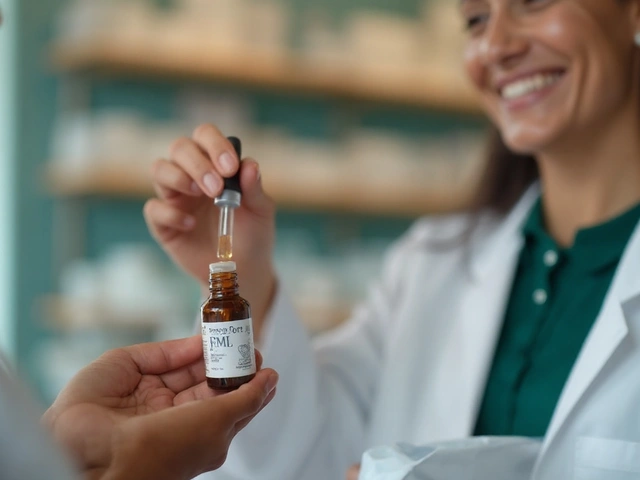Bromhexine is a mucolytic medication used to treat respiratory conditions where thick mucus makes breathing difficult. It doesn’t cure infections or stop coughing, but it helps your body clear mucus more easily. If you’ve been prescribed bromhexine for a stubborn chesty cough, you’re not alone - millions use it worldwide, especially in Europe and Asia, as a standard part of cold, bronchitis, and COPD treatment plans.
How Bromhexine Actually Works
Bromhexine breaks down the chemical bonds in thick mucus, making it less sticky and easier to cough up. It doesn’t increase mucus production - it changes the structure of what’s already there. Think of it like turning wet glue into watery sludge. Your airways are lined with mucus that traps dust, viruses, and bacteria. When you’re sick, that mucus thickens and sticks to the walls of your bronchi. Bromhexine targets the proteins and DNA strands that make mucus viscous, thinning it out so your cilia (tiny hair-like cells) can sweep it out more efficiently.
This is different from traditional expectorants like guaifenesin, which just increase fluid in the airways. Bromhexine works directly on mucus composition. Studies show it reduces mucus viscosity by up to 40% within hours of taking a dose. That’s why people often report feeling less congested after just one or two doses, even before their cough fully goes away.
Common Uses for Bromhexine
Bromhexine is most often prescribed for:
- Acute bronchitis - especially when mucus is thick and hard to clear
- Chronic obstructive pulmonary disease (COPD) - helps manage flare-ups
- Pneumonia recovery - aids in clearing post-infection mucus buildup
- Chronic sinusitis with post-nasal drip
- Pre- and post-surgery respiratory care - to prevent mucus blockage
It’s not used for dry, tickly coughs caused by allergies or viral irritation. If your cough is dry and doesn’t produce phlegm, bromhexine won’t help. It’s only effective when there’s actual mucus to break down.
Dosage and How to Take It
Bromhexine comes in tablets, syrup, and sometimes as an inhalation solution. The standard adult dose is 8 mg three times a day. For children, it’s weight-based: usually 1-2 mg per kg of body weight per day, split into three doses. Always follow your doctor’s instructions - overdosing doesn’t speed up results and can cause side effects.
Take it with food to reduce stomach upset. If you’re using syrup, shake the bottle well and measure with the provided dropper or cup. Don’t mix it with hot drinks - heat can reduce its effectiveness. It takes about 30-60 minutes to start working, and peak effects happen around 2-3 hours after ingestion.
Side Effects and Safety
Bromhexine is generally well-tolerated. The most common side effects are mild: nausea, stomach discomfort, dizziness, or a slight rash. These usually go away after a few days. Serious reactions are rare, but if you develop swelling of the face, lips, or throat, or trouble breathing, stop taking it and seek help immediately.
It’s considered safe during pregnancy (Category B), but always check with your doctor. It passes into breast milk in small amounts, so nursing mothers should consult a healthcare provider before use. Avoid alcohol while taking bromhexine - it can worsen dizziness and drowsiness.
People with stomach ulcers or severe liver disease should use it cautiously. Bromhexine is processed by the liver, so those with impaired function may need lower doses.

What It Doesn’t Do
Bromhexine is not an antibiotic. It won’t kill bacteria or viruses. If you have a bacterial infection like pneumonia, you’ll still need antibiotics. Bromhexine just makes it easier for your body to clear the mucus that comes with the infection.
It’s also not a decongestant. It won’t unblock your nose or reduce sinus pressure. If you’re stuffed up from allergies, you need an antihistamine or nasal spray. Bromhexine only helps with chest mucus.
And it doesn’t suppress coughing. Some people take it expecting to stop coughing altogether - but that’s not its job. In fact, you might cough more at first as the loosened mucus starts moving. That’s a good sign - you’re clearing your airways.
How It Compares to Other Mucolytics
Here’s how bromhexine stacks up against other common mucus-thinning drugs:
| Medication | Active Ingredient | How It Works | Typical Dose | Onset of Action |
|---|---|---|---|---|
| Bromhexine | Bromhexine hydrochloride | Breaks down mucus proteins | 8 mg three times daily | 30-60 minutes |
| Acetylcysteine | N-acetylcysteine | Breaks disulfide bonds in mucus | 200-600 mg three times daily | 15-30 minutes |
| Guaifenesin | Guaifenesin | Increases airway fluid secretion | 200-400 mg every 4-6 hours | 30 minutes |
| Ambroxol | Ambroxol hydrochloride | Similar to bromhexine; metabolite of it | 30 mg three times daily | 1 hour |
Ambroxol is actually a metabolite of bromhexine - meaning your body converts bromhexine into ambroxol to do the work. Some countries sell ambroxol directly as a more potent version. Both are effective, but bromhexine is often cheaper and more widely available over the counter in many regions.
When to Stop Taking It
Most people take bromhexine for 5-10 days. If your mucus is still thick and your cough hasn’t improved after two weeks, talk to your doctor. You might need a different treatment or further testing. Don’t keep taking it just because you think it’s helping - prolonged use without medical supervision can mask underlying problems like asthma, heart failure, or even early signs of lung disease.
Also, if you start coughing up blood, develop a high fever, or feel increasingly short of breath, stop immediately. These aren’t normal side effects - they signal something more serious.

Real-World Tips for Better Results
Medication alone won’t fix mucus buildup. Combine bromhexine with these habits:
- Drink plenty of water - at least 8 glasses a day. Hydration keeps mucus thin naturally.
- Use a humidifier - moist air helps loosen secretions.
- Practice controlled coughing - take a slow breath, hold it briefly, then cough twice to clear mucus without straining.
- Avoid smoke and strong fumes - they irritate your airways and make mucus worse.
- Elevate your head while sleeping - this helps mucus drain and reduces nighttime coughing.
Many patients report the biggest improvement when they combine bromhexine with daily hydration and steam inhalation. One study in Germany found that patients who drank 2 liters of water daily while taking bromhexine cleared mucus 30% faster than those who didn’t.
Where to Get It
In the United States, bromhexine is not FDA-approved and is not sold over the counter. You can find it as a prescription-only medication or through specialty import pharmacies. In Europe, Canada, Australia, and many Asian countries, it’s available without a prescription under brand names like Bisolvon, Mucosolvan, or Bromhexin.
If you’re in the U.S. and your doctor recommends it, they can write a prescription. Some online pharmacies ship it legally with a valid prescription. Be cautious of websites selling it without one - quality and safety can’t be guaranteed.
What to Ask Your Doctor
If you’re considering bromhexine, here are key questions to ask:
- Is my cough due to thick mucus, or is it dry and allergic?
- Could this interact with my other medications?
- Should I be tested for asthma or COPD if this keeps happening?
- Is there a reason you’re recommending bromhexine instead of guaifenesin or ambroxol?
- What signs should make me stop taking it?
Doctors appreciate patients who ask these questions. It shows you’re thinking about your health, not just grabbing a pill.
Is bromhexine the same as Mucinex?
No. Mucinex contains guaifenesin, which works by increasing fluid in your airways to thin mucus. Bromhexine changes the chemical structure of mucus itself. They both help with chest congestion, but they work differently. Some people find bromhexine more effective for thick, sticky mucus, while guaifenesin works better for general congestion.
Can children take bromhexine?
Yes, but only under a doctor’s guidance. Children’s doses are based on weight, not age. Liquid forms are available and often flavored to make them easier to take. Never give adult tablets to a child - even half a tablet can be too much.
How long does it take for bromhexine to work?
Most people notice mucus becoming looser within 30 to 60 minutes after taking a dose. Full benefits - like easier coughing and less chest tightness - usually show up after 2 to 3 days of consistent use. Don’t expect instant relief on the first day.
Can I take bromhexine with a cough suppressant?
Generally, no. Cough suppressants like dextromethorphan stop you from coughing, but bromhexine wants you to cough to clear mucus. Taking both can trap mucus in your lungs, increasing the risk of infection. Only combine them if your doctor specifically says it’s safe.
Is bromhexine addictive?
No. Bromhexine has no potential for abuse or dependence. It doesn’t affect the brain or nervous system. You won’t experience withdrawal symptoms if you stop taking it. It’s purely a physical mucus thinner, not a sedative or stimulant.
Next Steps
If you’ve been dealing with a persistent chesty cough, bromhexine might be worth discussing with your doctor - especially if you’ve tried over-the-counter remedies without success. Keep a symptom log: note when your cough is worst, what color your mucus is, and whether it’s getting easier to breathe. This helps your doctor decide if bromhexine is right for you.
Remember: clearing mucus is a process. It takes time, hydration, and the right tool. Bromhexine isn’t a miracle cure, but when used correctly, it can make a real difference in how you feel day to day.







Jenny Lee
November 19, 2025 AT 02:20Been using this for my chronic bronchitis-game changer. Finally can sleep without coughing.
Evan Brady
November 20, 2025 AT 01:09Let’s be real-guaifenesin is the placebo of mucolytics. Bromhexine actually restructures mucus at the molecular level. It’s not just thinning, it’s dismantling. The 40% viscosity drop in studies? That’s not marketing, that’s biophysics.
And yes, it’s why Europeans don’t need 10 different OTC cough syrups. They know the difference between fluid dilution and structural disruption. Guaifenesin? It’s like pouring water on a brick wall and calling it a solution.
Alex Boozan
November 20, 2025 AT 04:29Why does the U.S. still refuse to approve this? We’re the richest country on earth and we’re letting people suffer with Mucinex while Europe gets real medicine. This isn’t about safety-it’s about corporate lobbying. Big Pharma doesn’t want cheap, effective generics competing with their overpriced syrups.
Jonathan Gabriel
November 21, 2025 AT 10:27Wait-so bromhexine is metabolized into ambroxol? That means every time you take bromhexine, you’re basically taking a prodrug? So ambroxol isn’t just a variant-it’s the active end product?
Then why is ambroxol sold separately? Is it just bioavailability? Or are they just monetizing the same molecule twice? This feels like pharmaceutical sleight of hand.
mithun mohanta
November 22, 2025 AT 05:06Oh my god, I just realized-I’ve been using Mucinex for YEARS… and it’s just… water? Like, literally? I mean, bromhexine is like… molecular surgery… and I’ve been drinking sugar water with a hint of chemical? I feel so naive. Like I’ve been using a spoon to dig a tunnel. 😭
Emily Entwistle
November 23, 2025 AT 03:33Just started this last week for my post-COVID congestion and OMG it’s like my lungs finally remembered how to breathe 😍 I’m drinking 3L of water now and using a humidifier-this combo is 🔥🔥🔥
Gregory Gonzalez
November 24, 2025 AT 01:04Of course the U.S. doesn’t approve it. We don’t need science here-we need branding. Why let a $0.10 tablet solve a problem when you can sell a $20 bottle of syrup with a cartoon lung on it? Capitalism: where ignorance is profitable.
Kevin Jones
November 25, 2025 AT 04:25It’s not about efficacy. It’s about epistemology. We’ve normalized symptom management over mechanistic intervention. Bromhexine forces us to confront mucus as a physical substrate-not a nuisance to be masked. That’s why it’s vilified in markets built on placebo narratives.
Our medical infrastructure rewards volume, not precision. Hence: guaifenesin reigns.
Timothy Uchechukwu
November 25, 2025 AT 09:32Why are you all so obsessed with Western drugs? In Nigeria we use ginger, honey, and steam for centuries before you even knew what bromhexine was. This is just another example of medical colonialism-importing expensive chemicals while ignoring local wisdom. You think science is the only truth?
Jeff Hakojarvi
November 26, 2025 AT 17:03Hey, if you’re on this stuff, don’t forget to sip water like your life depends on it-because it kinda does. I had a patient last month who took bromhexine but only drank 1 glass of water a day… and got worse. The med needs hydration to work right. Also, avoid alcohol. You’ll feel like a zombie. I know, I’ve been there. You got this 💪
Samkelo Bodwana
November 27, 2025 AT 23:09I’ve lived in both the U.S. and South Africa, and the difference in how respiratory care is approached is staggering. Here, you get a prescription for an inhaler and a vague ‘drink fluids’ suggestion. In Cape Town, the pharmacist sat me down, explained mucus viscosity, showed me how to do postural drainage, and handed me bromhexine like it was bread. No drama. Just practical, human-centered care. We don’t need FDA approval to do right by people. We need empathy.
Ram tech
November 28, 2025 AT 01:24bro why are u even talking about this its just a cough med its not that deep. just take the pill and chill. also i think guaifenesin works fine. why u always gotta be so smart? lol
Bruce Bain
November 28, 2025 AT 09:20I’m from rural Texas. My grandma used to boil eucalyptus, rub Vicks on your chest, and make you drink hot tea with honey. We didn’t know what bromhexine was. But we got better. Maybe the real medicine is care-not chemistry.
Ronald Stenger
November 29, 2025 AT 02:06Let’s cut through the noise. Bromhexine isn’t some miracle drug. It’s a mild mucolytic with a 40% efficacy spike in controlled trials. But real-world outcomes? Minimal. Most patients improve because they’re resting, hydrating, and the virus ran its course. Don’t overvalue a drug that’s just one variable in a complex system. We’re glorifying correlation as causation.